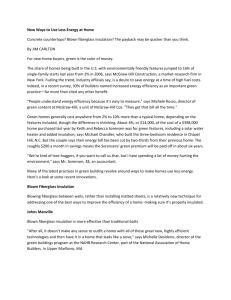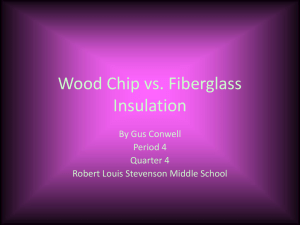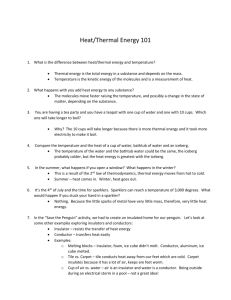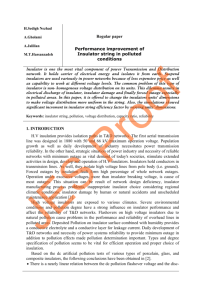Successful Science Fair Project
advertisement
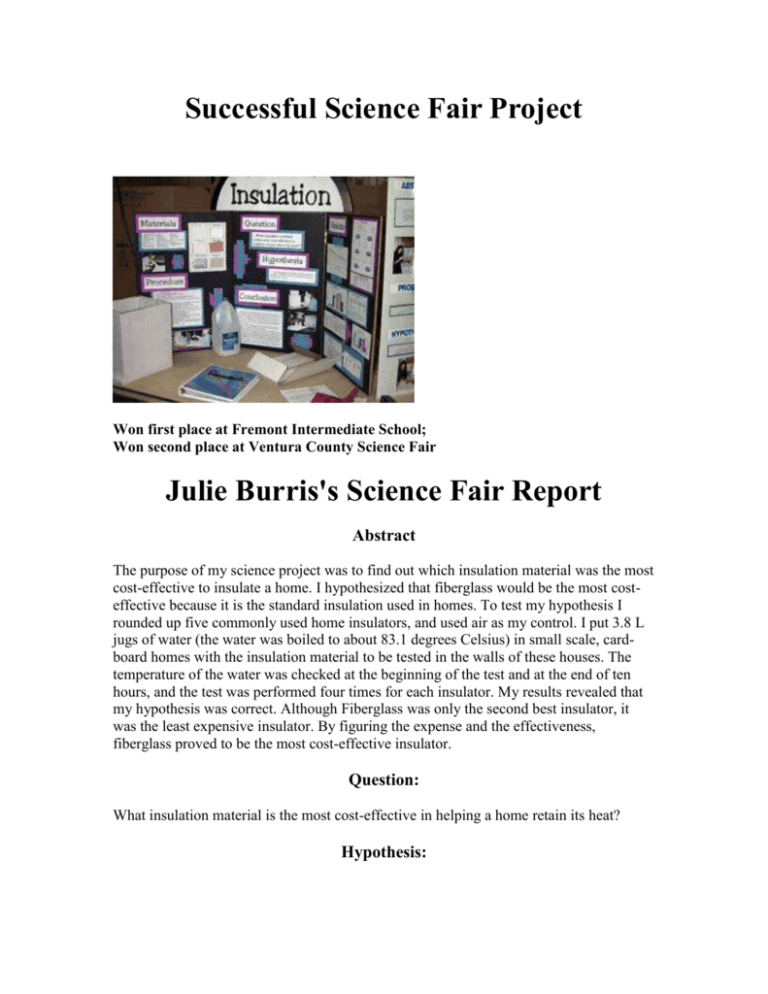
Successful Science Fair Project Won first place at Fremont Intermediate School; Won second place at Ventura County Science Fair Julie Burris's Science Fair Report Abstract The purpose of my science project was to find out which insulation material was the most cost-effective to insulate a home. I hypothesized that fiberglass would be the most costeffective because it is the standard insulation used in homes. To test my hypothesis I rounded up five commonly used home insulators, and used air as my control. I put 3.8 L jugs of water (the water was boiled to about 83.1 degrees Celsius) in small scale, cardboard homes with the insulation material to be tested in the walls of these houses. The temperature of the water was checked at the beginning of the test and at the end of ten hours, and the test was performed four times for each insulator. My results revealed that my hypothesis was correct. Although Fiberglass was only the second best insulator, it was the least expensive insulator. By figuring the expense and the effectiveness, fiberglass proved to be the most cost-effective insulator. Question: What insulation material is the most cost-effective in helping a home retain its heat? Hypothesis: I think that fiberglass will be the most cost-effective insulation material used in home construction. Materials: adhesive dot labels Asbestos pipe sections Calculator Candy thermometer 36 Cardboard boxes Ceiling Tile Clear packaging tape Clock 2 Coffee makers Computer Cooling rack Fiberboard Fiberglass blanket Foam sheathing Gypsum board (Drywall) Ice pick Masonite (0.35 cm thick) 2 Picnic benches 6 Plastic jugs (3.8 liter) Saber saw 2 Saw horses Steel-edged ruler Stove Tea kettle 6 Thin-stem thermometers Timer Utility knife Water (83.1 degrees Celsius) Procedure 1)Select and develop my topic. 2)Research my topic and form my hypothesis. 3)Select 5 common home construction insulation materials. 4)Purchase supplies and materials. 5)Calibrate my six thermometers and use adhesive labels to distinguish them apart 6)Punch 3.5 mm diameter hole in the lid of one plastic water jug. 7)Take six cardboard boxes 2.0 cm x 24.5 cm x 30.9 cm and fill them with one of the insulation materials to be tested. 8)Seal with clear packaging tape. 9)Attach five of the boxes together to create a 24.5 cm x 32.9 cm x 28.5 cm rectangular prism using clear packaging tape. This prism will represent a small scale house. 10)With the remaining box, punch a 3.5 mm diameter hole in the center of one side. 11)Heat 3.8 liters of water to about 83.1 degrees Celsius. 12)Pour water into 3.8 liter plastic water jug and seal tightly with lid containing 3.5 mm hole. 13)Place jug of hot water into small scale house. 14)Use remaining cardboard box to enclose the jug in the insulated walls of the simulated house. 15)Stick thermometer through hole in box and lid of 3.8 liter jug. 16)Place a section of asbestos pipe on top of house to pressure seal the lid. 17)Check temperature of water and the time. Record these readings. 18)Let experiment sit for 10 hours at about 17.7 degrees Celsius (room temperature in my garage). 19)Measure the temperature of the water in two hour increments and record. 20)Repeat this test for the other 4 insulators and my control, 4 times each. 21)Convert thermometer readings from Fahrenheit to Celsius. 22)Determine heat retention of control insulator (air) and use this temperature as "base temperature". 23)Compute the amount of heat retained by each insulation material above the base temperature. 24)Compute the cost for each insulation material. 25)Compute the cost-effectiveness of each insulation material. 26)Prepare charts and graphs. Conclusion After performing my tests for each insulator I figured out the heat retention for each material, the cost for each material, and the cost-effectiveness. Fiberglass was the most cost-effective insulator which made my hypothesis correct, but what I didn't expect was to have gypsum, the worst insulator besides air, take second place in cost-effectiveness. You see, gypsum was the second cheapest insulator, only costing me $0.51 to insulate the simulated home. The cheapest insulator was Fiberglass, only costing me $0.41. Air, which does not cost a penny, is used as an insulating barrier in combination with other insulators such as fiberglass and double-paned windows. I used air as my control. The most effective insulation material was foam sheathing, but unfortunately it was also the most expensive, and ended up being only the third most cost-effective. Fiberglass was only the second most effective insulator. This was my second year to do an experiment in the field of insulation, and this year my test materials and my conclusion were much more realistic. In last year's pro-ject sawdust was the most cost-effective. In fact it was more cost-effective than fiber-glass. The biggest problem with the results were that sawdust was not practical. It was subject to water damage, highly flammable, and it settles and compacts over time. Fiberglass, the most cost-effective insulator in this year's project, is much more practical and does not have negative reactions to water, fire, and gravity.

